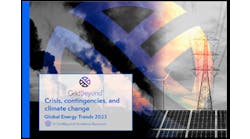Creating a smart city without first building a smart grid is a recipe for trouble. Power outages and an automated society are not friends.
Unfortunately, this basic fact gets obscured by the shiny objects smart cities promise: electric vehicles that find their own parking spaces, intelligent streetlights that double as safety patrols, garbage trucks that can distinguish between full and empty trash cans…to name a few.No doubt these services are good. But lost in the allure is the fact that antiquated energy infrastructure cannot support advanced technology. The American Society of Civil Engineers says that underinvestment in energy infrastructure has reached $177 billion.
“Smart cities have to be based on smart grids. If you don’t have electricity, those services people depend on become hard to provide from a city perspective,” said David Chiesa, S&C Electric’s senior director of business development.
That’s a message that S&C plans to deliver in Washington, D.C. March 15 at the “Smart Cities Powered by Smart Grids” roadshow.
The Chicago-based company is offering the afternoon seminar in keeping with its work as a lead partner with the Smart Cities Council. The session is geared toward municipal leaders, utilities and others interested in learning about first steps in creating a smart city.
Among other things, the council offers a readiness roadmap to help cities understand actions to take in creating a smart city.
“A lot of people look at it and say, ‘How do we start, what do we do? How do we make the transition from regular city to smart city?’ Having a roadmap to get from A to B is essential,” Chiesa said.
Smart cities and S&C are a good fit because the company offers the kind of electric distribution automation required for grid modernization. But the company’s kinship with the smart cities movement runs deeper, rooted in support for techologies that use “layered intelligence” (as opposed to centralized control).
Such intelligence can give parts of a system more autonomy. Smart city traffic management systems, which make decisions at the device level, offer an example. A street light senses that there is no cross traffic, so turns green, rather than keeping you waiting at a red light. Although the light is part of a larger traffic network, it makes the decision autonomously. A conventional street light, on the other hand, will rely on prescribed timing set by central control.
Similarly on the power grid, a smart city may include microgrids or other forms of advanced distributed energy that can act alone without central grid control. During a power outage a microgrid will automatically island from the main grid and keep serving local customers via its on-site generators. The customer will likely not even notice the switch.
[clickToTweet tweet=”Creating a Smart City? Do this First. #smartgrid” quote=”Creating a Smart City? Do this First.”]
Consumers demand this kind of service today, which was another impetus for S&C to become involved in the smart city movement.
“When you look at residents of cities these days they have higher expectations than they did in the past,” Chiesa said. “They want better performance of those services that brought them to the city to begin with, and they are pretty vocal about it.”
Smart city projects are particularly well suited for public power, especially smaller communities, given that they are governed locally and typically nimble in their decision-making. Investor-owned utilities are starting to make headway as well. But they sometimes face regulatory obstructions — state public utility commissions are wary of granting rate recovery for smart city projects that benefit only a discrete subset of customers.
The March 15 workshop will look at how to determine best candidates for smart city programs. The session also will offer details about the U.S. Green Building Council’s Performance Excellence in Electricity Renewal (PEER) program.
More details about the event are here.
Does your work involve creating a smart city? Describe your project in the comments below or on our LinkedIn Group, Distributed Energy Resources (DERs).







